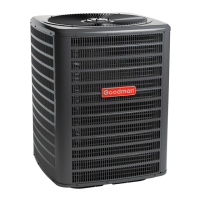What to do if Goodman Heat Pump has open control circuit?
- WWayne WilsonSep 10, 2025
To address an open control circuit in your Goodman Heat Pump, test the control circuit with a voltmeter.
What to do if Goodman Heat Pump has open control circuit?
To address an open control circuit in your Goodman Heat Pump, test the control circuit with a voltmeter.
How to fix a loose connection in a Goodman Heat Pump?
To resolve a loose connection in your Goodman Heat Pump, inspect the connection and tighten it.
How to resolve an overcharge of refrigerant in a Goodman GSX140601 Heat Pump?
To address an overcharge of refrigerant in your Goodman Heat Pump, recover a portion of the charge.
What to do if Goodman Heat Pump has too much air across indoor coil?
If your Goodman Heat Pump has too much air across the indoor coil, reduce the blower speed.
What to do if Goodman Heat Pump has shorted or broken wires?
If you have shorted or broken wires in your Goodman Heat Pump, test the circuits with an ohmmeter.
What to do if my Goodman Heat Pump has a blown fuse?
If your Goodman Heat Pump has a blown fuse, replace it, ensuring you use the correct fuse size and type.
What to do if Goodman GSX140601 has undersized suction line?
If you have an undersized suction line in your Goodman Heat Pump, replace the line.
What to do if Goodman GSX140601 has faulty evaporator fan motor?
If you have a faulty evaporator fan motor in your Goodman Heat Pump, repair or replace it.
How to test for a shorted or grounded compressor in a Goodman GSX140601 Heat Pump?
If you suspect a shorted or grounded compressor in your Goodman Heat Pump, test the motor windings.
How to troubleshoot a shorted or open capacitor in a Goodman GSX140601?
If you have a shorted or open capacitor in your Goodman Heat Pump, test the capacitor.
Crucial safety warnings and instructions for installation and servicing.
Essential guidelines for safely handling refrigerants to prevent injury or death.
Recommended procedure for testing system pressure before evacuation.
Step-by-step guide for evacuating the system using a vacuum pump.
Verifying airflow/static pressure and conditions before charge adjustment.
Methods for checking unit operation and refrigerant charge levels.
Procedure for charging fixed orifice systems using superheat.
Charging TXV systems using the subcooling method.
Using superheat for adjustable TXVs in unique applications.
Adjusting TXV superheat based on subcooling and superheat readings.
Linking symptoms to possible causes for troubleshooting.
Recommended test methods and corrective actions for common issues.
Checks to perform before calling a servicer for assistance.
Crucial safety warnings and instructions for installation and servicing.
Essential guidelines for safely handling refrigerants to prevent injury or death.
Recommended procedure for testing system pressure before evacuation.
Step-by-step guide for evacuating the system using a vacuum pump.
Verifying airflow/static pressure and conditions before charge adjustment.
Methods for checking unit operation and refrigerant charge levels.
Procedure for charging fixed orifice systems using superheat.
Charging TXV systems using the subcooling method.
Using superheat for adjustable TXVs in unique applications.
Adjusting TXV superheat based on subcooling and superheat readings.
Linking symptoms to possible causes for troubleshooting.
Recommended test methods and corrective actions for common issues.
Checks to perform before calling a servicer for assistance.
| Model | GSX140601 |
|---|---|
| Type | Heat Pump |
| Tonnage | 2.5 |
| SEER Rating | 14 |
| HSPF Rating | 8.2 |
| Refrigerant | R-410A |
| Compressor Type | Scroll |
| Sound Level | 76 dB |
| Voltage | 208/230V |
| Phase | 1 |
| Maximum Operating Temperature (Cooling) | 115°F |












